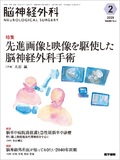Japanese
English
- 有料閲覧
- Abstract 文献概要
- 1ページ目 Look Inside
- 参考文献 Reference
Point
・定位的頭蓋内脳波(SEEG)は,開頭を要さず複数(平均10〜13本)の深部電極を定位的に脳内に留置して,ビデオ脳波同時記録を行う手法である.
・手術支援ロボットの発展により短時間で正確な深部電極留置が可能となったため,SEEGは世界中に普及してきている.
・SEEGの最大の合併症は頭蓋内出血であり,これに留意したプランニングや深部電極留置が必要である.
Subdural electrode (SDE) implantation and stereotactic electroencephalography (SEEG) represent two primary invasive monitoring techniques employed in epilepsy surgery. In North America, the advent of commercially available surgical robotic systems has initiated a paradigm shift from SDE to SEEG implantation. Advances in robotic technology have enabled the precise and efficient placement of depth electrodes for SEEG. In Japan, robot-assisted stereotactic electrode placement has been covered by National Health Insurance since 2020, further promoting its adoption. SEEG relies exclusively on intracerebral depth electrodes, which are stereographically inserted through twist drill holes or burr holes, eliminating the need for craniotomy—a requirement for SDE implantation. The planning of electrode trajectories is critical and must be meticulously performed using three-dimensional gadolinium-enhanced magnetic resonance imaging datasets to avoid vascular structures. Unlike SDE, SEEG allows for accurate sampling of cortical areas at the surface of hemispheres and bottom of sulci and deep-seated structures, such as the insular cortex, cingulate gyrus, and medial temporal lobes. This section provides a comprehensive overview of the indications for SEEG, the method of electrode implantation using robotic systems, the advantages of SEEG over other monitoring techniques, and its associated risks.

Copyright © 2025, Igaku-Shoin Ltd. All rights reserved.


